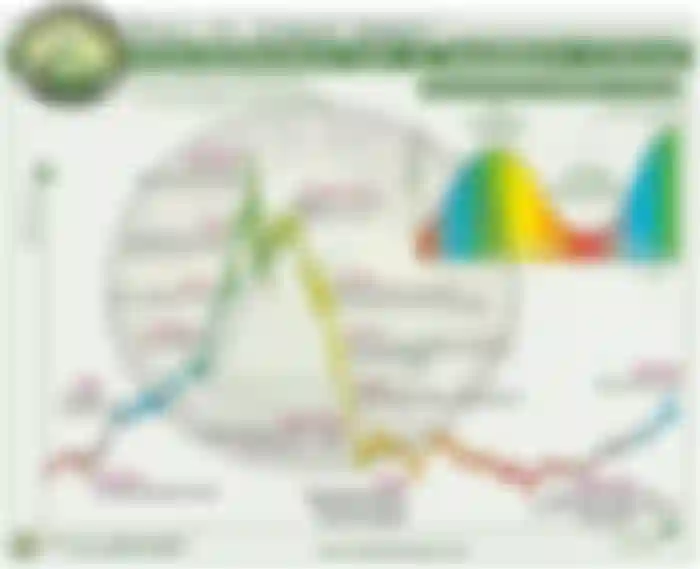With every crypto market cycle, some tokens fail, never to return. Whether it's because they're scams, have no tangible goals, no developers, or a lack of funding, it happens every time. 2018-2019 was a particularly brutal bear market, lasting over two years and depressing prices by over 80% for pretty much all crypto projects, some as much as 95%. This coin tanked in 2018 from its respective all-time high and endured the cold, long crypto winter. However, unlike many other unfortunate altcoins, this project managed to survive this cryptocurrency winter and has started to enter the "Recovery Phase."

This infographic illustrates the typical emotions that the general majority of traders and investors experience through each market cycle. This is a difficult cycle to observe yourself in real markets unless you zoom out far enough and perceive it with a critical eye. While they have suffered through the long 2018 crypto bear winter, they have started to show signs of life this year, some as recently as a few weeks ago. It takes a long time for investor sentiment to change, as we have been in a bearish state of mind since early 2018. However, coinciding with this chart, this project is starting to track price action commonly seen in the "Disbelief" or "sucker's rally" market stage. This is a commonly misconceived "bull trap," but rather a sign of higher lows and higher highs, thus breaking the long-term downtrend.
OmiseGo Network (OMG)
OMG Network (originally OmiseGO) is a non-custodial, Layer 2 scaling solution built on the Ethereum network to transfer value. The protocol transactional processes are centralized, but its Plasma-based design will decentralize network security.
At a high level, OMG Network is building a decentralized, borderless, trustless peer-to-peer network that allows anyone from anywhere in the world with a smartphone and an internet connection to transact with each other. Better yet, ETH 2.0 and Plasma's successful launches should enable these transactions to occur faster and more inexpensive than previously seen. To top it off, through the use of Plasma's child chains, the OMG Network will allow users to transact with each other using different currencies or value denominations, such as buying a Starbucks coffee using World of Warcraft gold or Jetblue loyalty rewards points, which the OMG Network will instantly convert to the Starbuck's POS' preferred value denomination (US Dollar, Euro, etc.), enabling a seamless transaction between two parties with different base currencies.

2018-Q1 2020 Bear Market
At the peak of the 2017-2018 Crypto bull run, OMG, along with other altcoins, saw a substantial price rise, jumping from $0.30 to ~$30 in about four months. Since its peak in early 2018, like many other altcoins, OMG's price crashed, dropping swiftly and relentlessly until ultimately bottoming at around $0.40 in March 2020. Since then, OMG spent a few months in a sideways trading phase after which buyers stepped in May with sizable purchase blocks, demonstrating longer-term accumulation. This marked a minor uptrend on shorter-term charts, with OMG gradually climbing higher.
Private Equity Funding
Omise, also known as "SYNQA," is Thailand's most successful online payments company and the parent company of OmiseGo Network. In June of of 2020, SYNQA raised $80 million in Series C funding led by Siam Commercial Bank subsidiary SCB 10X and the Asia-based venture capital group SPARX. Other investors included the Japan-based Toyota Financial Services Corporation, Sumitomo Mitsui Banking Corporation, SMBC Venture Capital, and the Aioi Nissay Dowa Insurance Corporation. Omise has solidified itself as a popular and provably integrative payments technology infrastructure that inspired and has since supported OMG's development and launch of its blockchain project, Plasma, and decentralized exchange.
OMG's team and mission is both supported and aligned with Omise's already-existing and widely-used payments system in Southeast Asia. There are a number of synergies and it goes without saying there are advantages to developing a new blockchain-based payments infrastructure with previous knowledge, personnel, and financial structures already in place from actively functioning and venture-backed payments systems. Lastly, one of the most exciting synergies OMG has is with is all the potential use-cases with portfolio companies also backed by SYNQA's investors, some of which are enormous and global-reaching, such as Toyota, Sumitomo Mitsui Bank, and more. This provides an easier transition and path to adoption of the network by major traditional market entities with global customer-bases and expansive payments needs.
Adoption
In June, exchange BitFinex announced they would be migrating over stablecoin Tether's (USDT) daily trading volume onto the OMG Network's first iteration. This was done promptly to capitalize on the Plasma sidechain's capability to reduce Ethereum gas congestion and reduce transaction fees, reducing confirmation times, making payments faster, and saving millions in monthly transaction fees while still receiving the same level of security as Ethereum. This is tremendous validation for OMG's legitimacy and value-add as a project, which has been in development since 2017. While many projects have been hunkered down and building during the long bear market winter, 2020-2021 appears to be the time that legitimate crypto projects that survived should start launching functional main nets. As ETH 2.0 comes online and OMG continues to rollout their completed platforms, this should attract more large companies to migrate their transaction volume onto the OMG Network. Some names that have been officially linked to expressing interest in OMG's network are Shinhan Card, Toyota Financial, and Sumitomo Mitsui Bank.
“By migrating USDt value transfers to the OMG Network we save costs, drive performance improvements and relieve pressure on the root chain network. This is good for Bitfinex and our customers, and the whole Ethereum ecosystem."
USDt is the world’s largest stablecoin and is issued on a variety of public blockchains including Algorand, Ethereum, EOS, Liquid, Omni and Tron. USDt is one of the most transacted assets and commands a high portion of transaction fees on the Ethereum network. According to Ethereum Gas Station, USDt gas fees amounted to US$6.39 million over the past 30 days.
Fixed Supply/Increasing Demand
The current circulating supply of 140,245,398 OMG tokens is also the fixed maximum supply. However, approximately one-third of all OMG are owned and locked up by OMG Network, reserved to be used to stake once Ethereum 2.0's Proof of Stake phase launches, thereby providing a source of renewable capital for OMG development. There is a strong similar sentiment among other investors as holders tend to lean towards accumulating more OMG to be able to stake for passive monthly OMG gains. There are currently 258 markets trading OMG Network, including mainstream exchanges such as Coinbase, Gemini, Kraken, and Binance. This means high liquidity and easy access for international investors everywhere, enabling OMG supply for higher demand.
GBV Acquisition
It was announced the first week of December that OMG Network was acquired by Genesis Block Ventures (GBV), a subsidiary of Genesis Block, a Hong Kong-based crypto OTC trading firm. The financial terms of the acquisition were not disclosed.
As part of the deal, GBV plans to grow the adoption of OMG Network (formerly OmiseGo) in Asia and beyond. "A number of integrations and partnerships are in the works," said GBV, adding that it will work with OMG "to leverage resources and explore new directions, such as building lending and trading platforms, to achieve DeFi's massive adoption and growth potential."
GBV has acquired OMG from SYNQA, its former parent company, which raised $80 million in Series C in June. As a result of the acquisition, OMG's team and business will move from SYNQA to GBV.
It appears the majority of operations, team, roadmap, and day-to-day processes will remain uninterrupted as new leadership takes over and steers a promising project toward large and legitimate institutional sources of liquidity. This was not seen as a particular weakness for OMG Network with the prompt onboarding of USDT's Bitfinex volume, but since then it appeared there wasn't much immediate interest enough to onboard new users. This will be a major next step for the OMG Network in its progress as the GBV leadership has indicated their top priority will be to maintain existing relationships and to form new ones for sustainable growth of the OMG Network which already has a live and functioning main product. While many retail investors are concerned why SYNQA would abandon its prized crypto project after years of research and development, reasons are unclear, but it's speculated that the SYNQA leadership took it as far as they were capable of and a more experienced, well-connected blockchain firm is taking over to push it to the next level. This is perhaps optimistic but as institutional interest in the crypto ecosystem increases by the day, real, bigger players with years -- even decades of experience scaling financial technology companies will be aggressive to seize potentially lucrative opportunities.
About Us:
If you enjoy these posts, please support the channel by "Tipping" this post below, or using either of the referral links below.
They cost you nothing and give me a small reward, which makes me a little happier to share these personal analyses with you at no cost.

